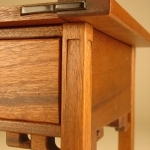Question: Why am I getting tear out on the box joints I’m cutting?
Situation: I’m cutting 1/2″ box joints, first in Western red cedar and then in African mahogany. I’m using what I think is a standard set up for the table saw–a 6″x 14″ x 1″ cedar backing board, a hardwood peg, a clamp, and the mitre guage. I have a Freud dado set which I’ve used for a year (moderate use).
Result: The box joint in both the cedar and the mahogany is perfectly clean on entry and about 80% of the way through the joint; then it is not so much “tear out” as crushed and ragged. I cleaned up the ragged part with a chisel quite easily, but the crushed and torn part shows when I dry fit the box.
Ideas appreciated,
Jim Bell
















Replies
Take a look at the Gary Rogowski video on the front page of FWW.com. He recommends using a slower feed rate through the saw. Tom
Thanks for the suggestion to put the wood through slower, but I'm feeding the boards at about half the speed that Rogowski is in the video clip, so I don't think feed rate is the problem. Any other ideas?
Jim
Jim,
Which dado set do you have? The SD200, SD500 and SD600 series dado sets have negative hook angles to reduce splintering/chipping on the face of the material (particularly across the grain) but this can cause blowout at the back of the cut. Most box joint operations are along the grain so a positive hook dado set like on the SD300 series (or the SBOX8 Box Joint Cutter except that it is for 1/4" and 3/8" box joints) is a better choice and produces less blowout. Also, you said 1/2" box joints but you didn't say how deep. This could be a factor since removing too much material in one pass can cause blowout with any dado set.
Freud America, Inc.
You might also try a harder wood in the backing board. the compressibility of cedar means that it might not be supporting the wood at the cutting edge any more.
Umberto Eco, The Island of the Day Before
Mr F,
Your observation may be at least part of the answer.
I have only machine cut finger joints with a router cutter. One of the methods employs the Veritas router table and crosscut sled, which uses a similar setup to that with a dado blade - except one employs a router cutter, naturally. :-)
The Veritas design for this process uses the endgrain of a piece of truly hard wood (eg beech or other rigid, close grained stuff) to prevent blow out as the bit goes through the back of the work piece; and it works perfectly.
The nature of the wood used in this sacrificial backing block does make a big difference - soft or brittle stuff does not work well, especially if used long rather than end grain-wise. Perhaps it is worth trying a thick slice of something like beech as the sacrificial support with the dado, cut so that its endgrain abuts the back of the workpiece?
Lataxe
The Report Back
OK, I put an African mahogany board (on which I'd made a bad cut) behing the boards I was cutting the box joint in. I cut two boards (e.g., front and back boards) at once with the mahogany between them and the old cedar fence. I moved the sacrificial board with every cut so there was fresh backing.
I also thoroughly cleaned the blades of my Freud 506/508 dado set.
On some cuts, I clamped the bundle of three boards together; on others I squeezed them by hand. Result: no tear out on the two boards! And still tear out on the (sacrificial) mahogany board immediately in front of the cedar. So I figure the soft cedar was the major problem. Thanks very much for the help.
Jim Bell
Try using something very hard like masonite for the backer board, and move it constantly so it's always fresh for every cut.
David Ring
http://www.touchwood.co.il/?id=1&lang=e
As Charles M stated the Freud Box Joint set of blades is great, I've used it and love it. I like to lightly double side tape all the sided together plus a back up piece and run them all at once. This practice cuts tearout to nothing or minimum. Remember to offset two pieces so you get the necessary off set.
Work Safe, Count to 10 when your done for the day !!
Bruce S.
I've got theh Freud SD 200. I'll try your various suggestions, starting with putting more than one board through and using a sacrificial piece of hard wood as a second backing board. Many thanks.
Jim Bell
This forum post is now archived. Commenting has been disabled